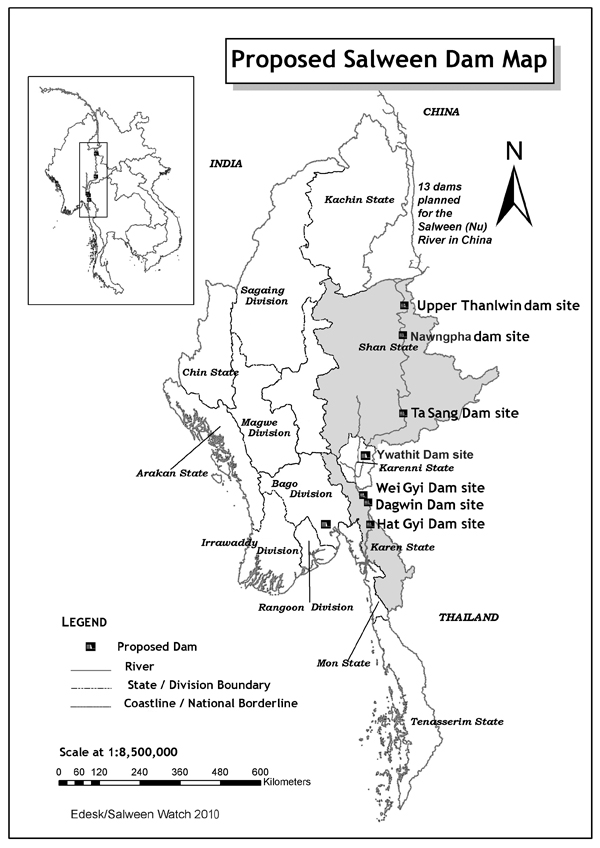Sai Sai, head of the Shan Sapawa environmental group and leading member of Burma Rivers Network (BRN), told SHAN today completion of the 7 mega dams on the Salween would strangle the struggle of the resistance armed movements fighting for self-rule...
Sai Sai, head of the Shan Sapawa environmental group and leading member of Burma Rivers Network (BRN), told SHAN today completion of the 7 mega dams on the Salween would strangle the struggle of the resistance armed movements fighting for self-rule.
 Speaking on the sidelines of the press conference launching “Stop the Dam Offensive against the Karenni” at an undisclosed venue on the Thai-Burma border, he said, “There are 7 dams being planned on the Salween. 7 dams mean 7 man-made lakes, which wills be closely guarded by tens of thousands of the Burma Army troops. The resistance fighters trying to cross the river will become sitting ducks.”
Speaking on the sidelines of the press conference launching “Stop the Dam Offensive against the Karenni” at an undisclosed venue on the Thai-Burma border, he said, “There are 7 dams being planned on the Salween. 7 dams mean 7 man-made lakes, which wills be closely guarded by tens of thousands of the Burma Army troops. The resistance fighters trying to cross the river will become sitting ducks.”
The projected 7 dams, from north to south, are: Kunlong, Nawng Pha and Tasang in Shan State; Ywathit in Karenni (Kayah) State; and Weigyi, Dagwin and Hutgyi in Karen State.
The Kachin Independence Army (KIA), Shan State Army (SSA) ‘North’, Shan State Army (SSA) ‘South’, United Wa State Army (UWSA), Karenni Army (KA) and the Karen National Liberation Army (KNLA) are active on both sides of the Salween, whose headwaters are in China
Of the 7 projects, Hutgyi and Tasang appears to be the most advanced:
Electricity Generating Authority of Thailand (Egat), China and Naypyitaw signed an MoA to go ahead in April 2010
Egat, Burma and China’s Three Gorges Group Corporation signed MoU on Tasang on 11 November 2010, just 4 days after the elections were held
“Egat had taken over from the MDX group (that had been working on Tasang since (1997),” he explained. “And the projected expenditure has been raised from $ 6 billion to $ 10 billion now.”
The Karenni Development Research Group (KDRG) has expressed 6 main concerns that the dams are:
- Fueling conflict and instability
- Forging ahead in secret (without information or consultation to/ with the local population)
- Destroying forests and biodiversity
- Reducing agricultural production
- Threatening indigenous peoples
- Locating water surges and shortages
“We, the people, are the host,” complained a Kayah resident who requested anonymity. “It is insulting when the guest is doing what is wants without asking the host.
“It is also meaningless to call our state Kayah and then doing what it can to destroy the people of Kayah.”
Thaw Reh, who had made the main presentation, agreed. “They also like to say it is for the benefit of the community, while all the time it is for themselves,” he charged.
Thaw Reh said he was taking advantage of the fact that Beijing is currently holding the National People’s Congress (NPC) to organize the press conference. “There must be peace before development,” he maintained. “And for every development project to go ahead, the participation of the people is imperative.”
The SSA South, in whose operational territory the Tasang hydropower project is located, has said it would bow to the will of the people on the subject. In the meanwhile, the road construction from Mongpan, west of the Salween, to Monghta, east of the Salween, near Tasang, has been suspended because of warnings from the local activists, said Sai Sai.


